-
Car Reviews
- All reviews
- Midsize SUVs
- Small cars
- Utes
- Small SUVs
- Large SUVs
- Large cars
- Sports SUVs
- Sports cars
- Vans
Latest reviews
- Car News
-
Car Comparisons
Latest comparisons
- Chasing Deals
Mercedes-Benz is well on its way to meeting its goal of electrifying all its cars by 2030, but to get there it’s going to need a lot of great, battery-powered machines. And a key model in that game plan is the new large-segment Mercedes-Benz EQE SUV.
While the initial EQC midsize SUV didn’t exactly light the world on fire, the EQS luxury sedan and its SUV sibling have proven to be impressive, stately examples of luxury EV motoring.
The EQE sedan delivers much the same experience on a smaller, (slightly) more affordable scale. And now it’s time for that large sedan, too, to get the SUV treatment.

The EQE SUV is a taller, more practical version of the EQE sedan though, interestingly, at 4860mm in length, it’s shorter than its four-door twin. That said, the SUV uses the same EVA2 platform, has the same 90.6kWh battery pack, and is even driven by the same single- or dual-electric motor configuration.
Likewise, power is the same, with 300kW and a huge 858Nm for the top-shelf EQE SUV 500 4Matic.
Meanwhile, at the low end of the range, the rear-wheel-driven 350+ model makes do with 215kW and 565Nm. For its part, the dual-motor 350 4Matic also has the same 215kW rating, but adds an extra 100Nm of torque for 765. But that’s not the only thing the dual-motor flavour adds.
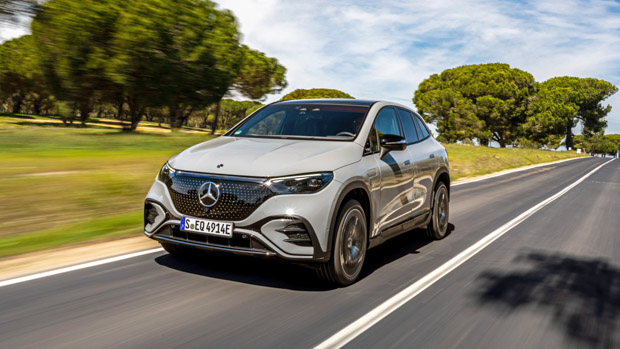
The EQE SUV introduces a new front drivetrain layout that allows the car to effectively disconnect the front motor from the front driveshafts. This means the car can behave like a rear-wheel-drive car or an all-wheel drive.
Now, we’ve seen performance cars like the BMW M5 do this trick in the past, turning them into drift monsters at the touch of a button.
With the EQE SUV, the intent is a little more frugality minded. In Comfort or Eco modes, the car mostly drives on the rear motor, disconnecting the front to reduce the parasitic loss of keeping that second motor spinning.

It’s only under hard acceleration or significant regenerative braking that the front driveshafts are re-engaged, a process that takes about a quarter of a second.
That process helps to give the 4Matic version better range, but you’ll still pay a penalty over the sedan. Maximum range on the EQE SUV is 596km for the rear-wheel-drive 350+ model.
Opting for the 4Matic drops that range potential down to 551, while the full-fat 500 model does 552. Whichever way you go, the variants fit a 90.6kWh battery pack based on a 400-volt system.
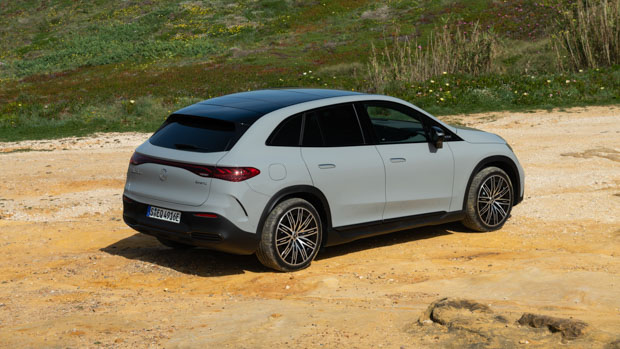
Performance? The tree-topping 500 will dispatch the 0-100kmh sprint in a claimed 4.9 seconds in Sport mode.
In Sport mode, that front motor is always engaged, providing maximum torque. Whether you opt for the 350 or the full-fat 500 4Matic, the EQE SUV is genuinely quick off the line. Even the rear-wheel-drive edition has strong initial acceleration, only starting to taper off as it approaches freeway speeds.
When it comes to slowing down again, the EQE SUV can be a little uneven. Like on the other EQs, the brake pedal adjusts its position and feel based on some mixture of factors that I still haven’t figured out.
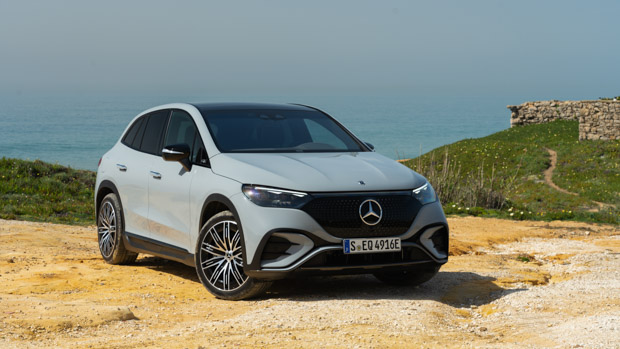
There are two regen modes, but even the stronger isn’t strong enough for proper one-pedal driving, and the Intelligent mode, which adds or removes regen based on traffic and upcoming turns, still doesn’t feel right to me.
That said, everything else about the way the EQE SUVs drive does feel great. This car is a genuine pleasure to drive, if you drive it right.
The range sits on a choice of steel-sprung or air suspension, at least overseas where we got to sample the EQE range. The jury is out as to standard Aussie fitment or, indeed, if the tuning of the available systems will vary for local conditions.

But pushed hard, the EQE SUV tends to just sort of lumber through the turns, cornering well but seemingly not enjoying it. Better to take a more relaxed attitude here, enjoy the cosseting ride quality and the tomb-like silence that this SUV’s engineers spent so many hours perfecting.
We didn’t get to sample the hotter AMG stock, which currently includes the AMG EQE 43 and EQE 53 trims. They’ll undoubtedly be positioned as more spirited corner carvers.
For the regular Benz stock, the silence is filled by default with a seven-speaker sound system from Mercedes-Benz’s house premium audio brand Burmester. If you’re willing to spend a little more you can upgrade to more speakers, but even the base system offers Dolby Atmos.

Likewise, you may not need to splurge for the triple-display Hyperscreen setup. Opt for this and you get a 17.7-inch widescreen OLED panel inset into the dashboard, flanked by two more displays.
On the left is a 12.3-inch virtual gauge cluster, while on the right is another 12.3-inch display purely for the passenger, which they can use to control the media system or even stream movies.
It’s a stunning digital array to behold, but given the base model still has a 12.8-inch display in the middle position, it’s hardly slumming on the entry grade.
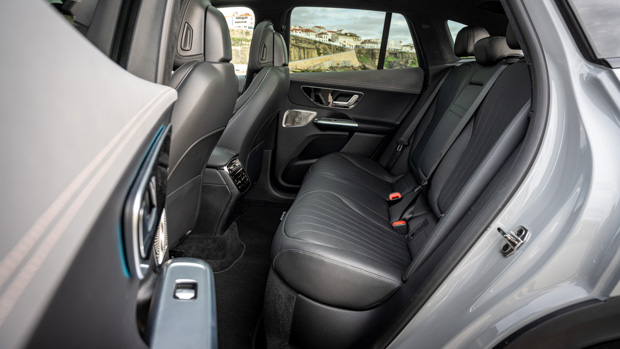
You can also spec the AMG-line trim, which provides a little more visual aggression inside and out, with a slightly different nose and a racier, flat-bottomed steering wheel. But again even the base EQE SUV interior looks great, with quality materials everywhere and what is simply a clean, attractive design.
It’s roomy, too, far more so than the sedan, which can feel a bit cramped, especially in the back seat. In the SUV there’s plenty of space front or back, plus a feeling of openness that’s made all the more dramatic should you add on the panoramic sunroof.
The biggest change over the sedan, though, is cargo space. That hatch means 580 litres worth, expanding to 1675 litres if you fold the seats flat.
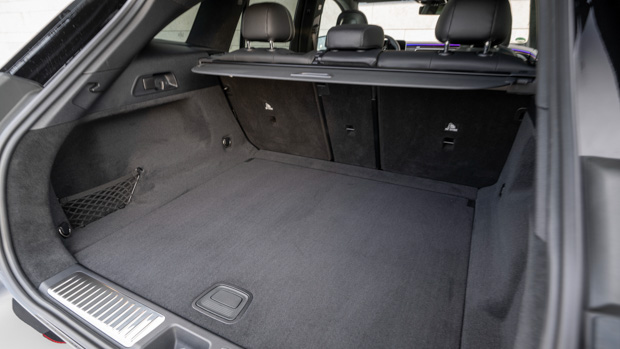
Surprisingly, that change of profile makes for a more handsome car. To me the EQE sedan just looked very vague, but the SUV is more visually compelling. Its taller shape forces it into a slightly more aggressive stance, which turns it from anonymous to acceptable.
It is, simply, a great-driving luxury EV with a rather more attainable price than the larger EQS SUV and a far more comfortable and liveable layout than the sedan.
Formal pricing for the Australian market is not yet available, but in the US, the EQE SUV costs between $3,000 and $4,000 more than a comparable sedan for the 350+ and 500 4Matic trims, though interestingly the 350 4Matic costs exactly the same.

For context, here in Australia, the EQE 300 and 350 4Matic sedans are available currently in non-AMG guises, priced at $134,900 and $154,900 respectively.
That’s not much of a premium for a more practical, more handsome and generally more comfortable choice.
We look forward to driving the local spec once the EQE SUV arrives in Australia in Q3 this year.
About Chasing cars
Chasing Cars reviews are 100% independent.
Because we are powered by Budget Direct Insurance, we don’t receive advertising or sales revenue from car manufacturers.
We’re truly independent – giving you Australia’s best car reviews.
The estimate provided does not take into account your personal circumstances but is intended to give a general indication of the cost of insurance, in order to obtain a complete quote, please visit www.budgetdirect.com.au. Estimate includes 15%^ online discount.
^Conditions Apply
Budget Direct Insurance arranged by Auto & General Services Pty Ltd ACN 003 617 909(AGS) AFSL 241 411, for and on behalf of the insurer, Auto & General Insurance Company Limited(ABN 42 111 586 353, AFSL 285 571).Because we don’t know your financial needs, we can’t advise you if this insurance will suit you. You should consider your needs and the Product Disclosure Statement before making a decision to buy insurance. Terms and conditions apply.
Indicative quote based on assumptions including postcode , 40 year old male with no offences, licence suspensions or claims in the last 5 years, a NCD Rating 1 and no younger drivers listed. White car, driven up to 10,000kms a year, unfinanced, with no modifications, factory options and/or non-standard accessories, private use only and garaged at night.
^Online Discounts Terms & Conditions
1. Discounts apply to the premium paid for a new Budget Direct Gold Comprehensive Car Insurance, Third Party Property Only or Third Party Property, Fire & Theft Insurance policy initiated online on or after 29 March 2017. Discounts do not apply to optional Roadside Assistance.
2. Discounts do not apply to any renewal offer of insurance.
3. Discounts only apply to the insurance portion of the premium. Discounts are applied before government charges, taxes, levies and fees, including instalment processing fees (as applicable). The full extent of discounts may therefore be impacted.
4. We reserve the right to change the offer without notice.